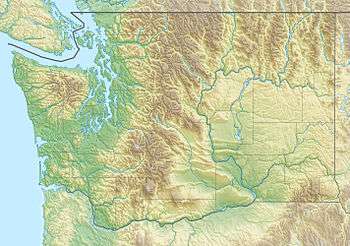Red Mountain (Washington)
Red Mountain is located in the southeast corner of Washington state near the Tri-Cities between Rattlesnake Mountain and Candy Mountain. This region is situated among the Columbia, Snake and Yakima Rivers. The mountain covers an area of approximately 4,040 acres (16.3 km2).
| Red Mountain | |
|---|---|
Red Mountain as seen from the east in 2007. | |
| Highest point | |
| Elevation | 1,410 ft (430 m) NGVD 29[1] |
| Prominence | 720 ft (220 m) [1] |
| Coordinates | 46°17′52″N 119°26′27″W [2] |
| Geography | |
 Red Mountain Benton County, Washington, U.S. | |
| Topo map | USGS Benton City |
Red Mountain AVA, Washington's smallest wine region appellation, is situated on the south-facing slope of Red Mountain, between the cities of Benton City and West Richland within the larger Yakima Valley. About 700 of the area's 4,040 acres (16.3 km2) are planted to winegrapes, which mainly include Cabernet Sauvignon, Merlot, Cabernet franc, Syrah and Sangiovese. The area is home to 37 wineries.
In 2001, the federal government recognized the Red Mountain area as an official American Viticultural Area.[3] Some of Washington's top estates are sourcing grapes from the Red Mountain AVA. The sandy loam soil of the region is high in calcium and alkaline. Red Mountain's vineyards are characterized by good air drainage, light soils and deeply rooted vines. With only 6 to 8 inches (200 mm) of annual rainfall, area growers must irrigate, which allows them to control vine vigor and ease vines into dormancy before winter. Red Mountain's growing season averages 180 days.
Nearby cities and towns
Benton City, Kennewick, Pasco, Prosser, Richland, West Richland.
References
- "Red Mountain, Washington". Peakbagger.com.
- "Red Mountain". Geographic Names Information System. United States Geological Survey.
- Barron's accessed November 10, 2019